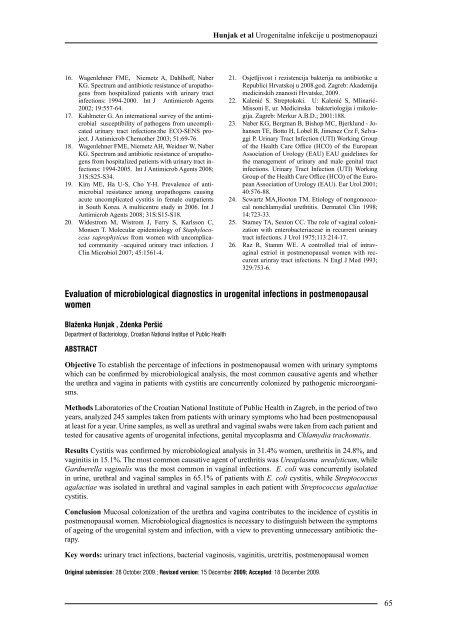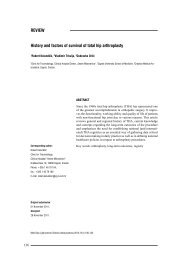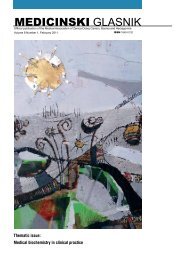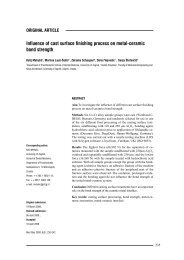Značenje mikrobiološke dijagnostike u infekcijama urogenitalnog ...
Značenje mikrobiološke dijagnostike u infekcijama urogenitalnog ...
Značenje mikrobiološke dijagnostike u infekcijama urogenitalnog ...
You also want an ePaper? Increase the reach of your titles
YUMPU automatically turns print PDFs into web optimized ePapers that Google loves.
16. Wagenlehner FME, Niemetz A, Dahlhoff, Naber<br />
KG. Spectrum and antibiotic resistance of uropathogens<br />
from hospitalized patients with urinary tract<br />
infections: 1994-2000. Int J Antimicrob Agents<br />
2002; 19:557-64.<br />
17. Kahlmeter G. An international survey of the antimicrobial<br />
susceptibility of pathogens from uncomplicated<br />
urinary tract infections:the ECO-SENS project.<br />
J Antimicrob Chemother 2003; 51:69-76.<br />
18. Wagenlehner FME, Niemetz AH, Weidner W, Naber<br />
KG. Spectrum and antibiotic resistance of uropathogens<br />
from hospitalized patients with urinary tract infections:<br />
1994-2005. Int J Antimicrob Agents 2008;<br />
31S:S25-S34.<br />
19. Kim ME, Ha U-S, Cho Y-H. Prevalence of antimicrobial<br />
resistance among uropathogens causing<br />
acute uncomplicated cystitis in female outpatients<br />
in South Korea. A multicentre study in 2006. Int J<br />
Antimicrob Agents 2008; 31S:S15-S18.<br />
20. Widestrom M, Wistrom J, Ferry S, Karlsson C,<br />
Monsen T. Molecular epidemiology of Staphylococcus<br />
saprophyticus from women with uncomplicated<br />
community –acquired urinary tract infection. J<br />
Clin Microbiol 2007; 45:1561-4.<br />
21. Osjetljivost i rezistencija bakterija na antibiotike u<br />
Republici Hrvatskoj u 2008.god. Zagreb: Akademija<br />
medicinskih znanosti Hrvatske, 2009.<br />
22. Kalenić S. Streptokoki. U: Kalenić S, Mlinarić-<br />
Missoni E, ur. Medicinska bakteriologija i mikologija.<br />
Zagreb: Merkur A.B.D.; 2001:188.<br />
23. Naber KG, Bergman B, Bishop MC, Bjerklund - Johansen<br />
TE, Botto H, Lobel B, Jimenez Crz F, Selvaggi<br />
P. Urinary Tract Infection (UTI) Working Group<br />
of the Health Care Office (HCO) of the European<br />
Association of Urology (EAU) EAU guidelines for<br />
the management of urinary and male genital tract<br />
infections. Urinary Tract Infection (UTI) Working<br />
Group of the Health Care Office (HCO) of the European<br />
Association of Urology (EAU). Eur Urol 2001;<br />
40:576-88.<br />
24. Scwartz MA,Hooton TM. Etiology of nongonoccocal<br />
nonchlamydial urethtitis. Dermatol Clin 1998;<br />
14:723-33.<br />
25. Stamey TA, Sexton CC. The role of vaginal colonization<br />
with enterobacteriaceae in recurrent urinary<br />
tract infections. J Urol 1975;113:214-17.<br />
26. Raz R, Stamm WE. A controlled trial of intravaginal<br />
estriol in postmenopausal women with reccurent<br />
urinray tract infections. N Engl J Med 1993;<br />
329:753-6.<br />
Evaluation of microbiological diagnostics in urogenital infections in postmenopausal<br />
women<br />
Blaženka Hunjak , Zdenka Peršić<br />
Department of Bacteriology, Croatian National Institue of Public Health<br />
ABSTRACT<br />
Hunjak et al Urogenitalne infekcije u postmenopauzi<br />
Objective To establish the percentage of infections in postmenopausal women with urinary symptoms<br />
which can be confirmed by microbiological analysis, the most common causative agents and whether<br />
the urethra and vagina in patients with cystitis are concurrently colonized by pathogenic microorganisms.<br />
Methods Laboratories of the Croatian National Institute of Public Health in Zagreb, in the period of two<br />
years, analyzed 245 samples taken from patients with urinary symptoms who had been postmenopausal<br />
at least for a year. Urine samples, as well as urethral and vaginal swabs were taken from each patient and<br />
tested for causative agents of urogenital infections, genital mycoplasma and Chlamydia trachomatis.<br />
Results Cystitis was confirmed by microbiological analysis in 31.4% women, urethritis in 24.8%, and<br />
vaginitis in 15.1%. The most common causative agent of urethritis was Ureaplasma urealyticum, while<br />
Gardnerella vaginalis was the most common in vaginal infections. E. coli was concurrently isolated<br />
in urine, urethral and vaginal samples in 65.1% of patients with E. coli cystitis, while Streptococcus<br />
agalactiae was isolated in urethral and vaginal samples in each patient with Streptococcus agalactiae<br />
cystitis.<br />
Conclusion Mucosal colonization of the urethra and vagina contributes to the incidence of cystitis in<br />
postmenopausal women. Microbiological diagnostics is necessary to distinguish between the symptoms<br />
of ageing of the urogenital system and infection, with a view to preventing unnecessary antibiotic therapy.<br />
Key words: urinary tract infections, bacterial vaginosis, vaginitis, uretritis, postmenopausal women<br />
Original submission: 28 October 2009.; Revised version: 15 December 2009; Accepted: 18 December 2009.<br />
65












